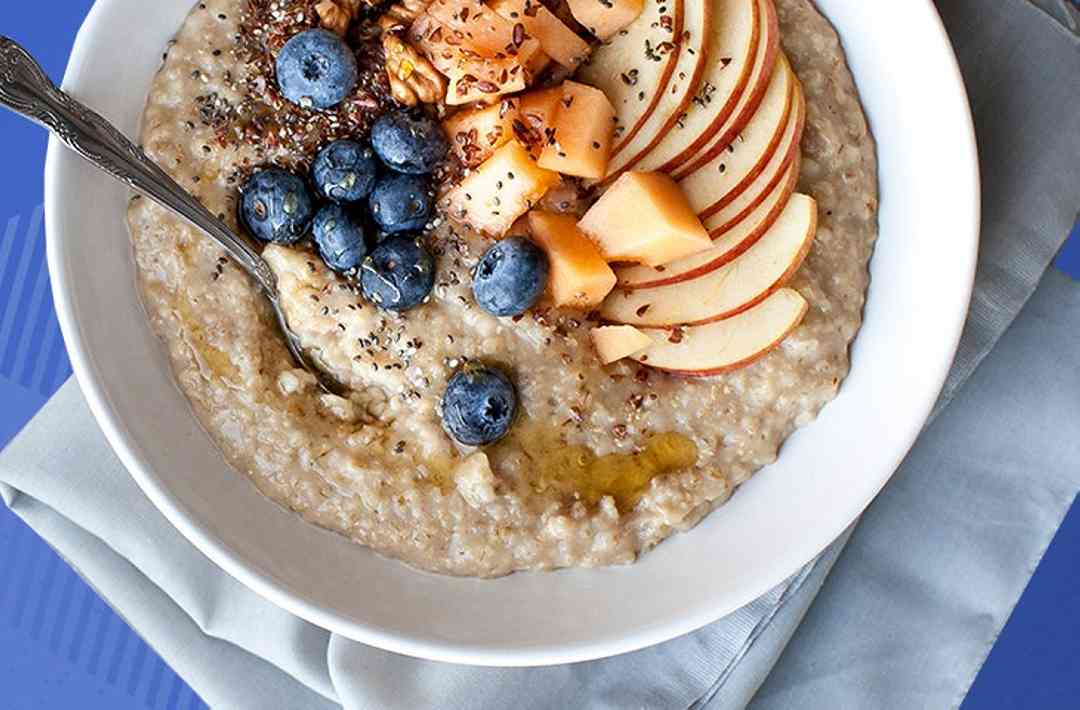
You’ve surely heard all about fiber and its many virtues. For starters, we know that eating lots of fiber-filled foods is associated with a regular pooping schedule, but it’s also associated with improved heart health, feeling full and satisfied after meals, and keeping your blood sugar stable. But how much should you actually be eating—especially if your main goal is to go to the bathroom regularly? Here’s the deal on how much fiber you actually need to be eating.
What fiber does
Dietary fiber is a kind of carb found in plant foods, including whole grains (like oats, barley, and whole wheat pasta), legumes (lentils, beans), nuts, seeds, fruits, and vegetables. Its structure makes it difficult for our digestive systems to break down, so it largely passes on through, the Food and Drug Administration (FDA) explains.
There are two types of fiber: soluble, which dissolves in water to create a gelish substance, and insoluble, which doesn’t break down at all. Certain foods might be higher in one or the other, but most plant foods usually contain some of both.
We need fiber in our diets for a few reasons. First and foremost is the pooping aspect, obviously. “Adequate fiber intake is very important for regular bowel movements and digestive health,” Christine Lee, M.D., a gastroenterologist at Cleveland Clinic, tells SELF.
Insoluble fiber is especially critical in this regard. It helps add bulk to your stool, and accelerates the movement of food through the digestive system to prevent you from getting backed up, according to the FDA. The result? Softer stools and more consistent bowel movements, Dr. Lee says.
Soluble fiber actually has the opposite effect: It slows down digestion, which prevents all of the food you eat from being broken down and excreted too rapidly. That’s why you generally want both, so they can sort of balance each other out and keep things regular.
Fiber is beneficial in other ways, too. It helps regulate the levels of your LDL cholesterol and blood sugar, per the FDA, and it can help increase feelings of fullness for longer after a meal.
How much fiber you need
Now, the answer you’re here for. The Dietary Guidelines correlate your optimal fiber intake with your caloric intake. They say people should get about 14 grams of fiber for every 1,000 calories in their diet. In general, fiber recommendations also vary according to age and sex—for example, the recommendation is highest for men in their 20s, because the number is based off projected caloric intake.
Now, remember that the Dietary Guidelines are just that: guidelines, not rules. Your daily caloric intake isn’t necessarily that cookie-cutter average 2,000 calories per day—we all have different nutritional needs and ways of eating that work for us. At the end of the day, we’re all a little different, and so are our fiber needs, Dr. Lee says, for a variety of reasons. Some of this is just individual variation. Your gut might be more or less sensitive to fiber than other people’s, Dr. Lee says. Or maybe you just feel better eating a bit more or less than recommended, for reasons only your gut knows.
There are also lifestyle factors that can affect your fiber requirements in the short or long term. One is your activity level, because exercise can help move digestion along. So an athlete might need to eat less fiber to be regular than someone who doesn’t work out much, Dr. Lee says. Another one is stress, Dr. Lee says, which can cause diarrhea in many people and constipation in others because the digestive system and the brain communicate with each other, as SELF previously reported.
And there are some medical factors to consider. Having any kind of GI condition can definitely affect your ideal fiber intake in either direction, Dr. Lee says. That includes Crohn’s disease, ulcerative colitis, celiac disease, chronic pancreatitis, irritable bowel syndrome (IBS), and diverticulosis or diverticulitis. This is extremely variable across conditions, people, and the course of illness, so it’s really important for anyone with a digestive issue to talk to their doctor about how it might impact their fiber needs, Dr. Lee says. For instance, people with irritable bowel syndrome (IBS) may find that fiber helps decrease symptoms like bloating, pain, and diarrhea, according to the Cleveland Clinic, while certain fibrous foods like fruit, broccoli, and Brussels sprouts can actually cause bloating and gas.
Same goes for any non-GI condition that affects your digestive system. For example, stroke and diabetes can cause constipation by impacting the muscles or nerves involved in bowel movements, according to the National Institute on Aging (NIA). Since the first-line treatment for constipation is generally consuming more fiber (along with water and exercise), per the NIDDK, doctors may recommend eating more fibers. There are also a number of medications that can have constipation or diarrhea as a side effect, Dr. Lee says, such as opioid pain relievers. If a condition or medication is causing you to experience either problem, talk to your doctor about whether you should cut down on your fiber (in the case of diarrhea), or boost it (in the case of constipation), or if certain kinds of fibery foods might be better for you than others.
What happens when you get too little (or too much) fiber
As you may have unpleasantly experienced at some point in your life, too little fiber can cause digestive issues like constipation. But there is good evidence associating adequate or high dietary fiber intake with a reduced risk of chronic conditions like heart disease and type 2 diabetes, according to the Academy of Nutrition and Dietetics (AND). That said, we don’t know for sure if it’s fiber specifically that’s associated with these benefits, since someone who eats a lot of dietary fiber is likely eating a diet with lots of fruits and vegetables. That same person may also enjoy regular exercise. The point is, the correlation between high dietary fiber intake and reduced risk of health conditions does not necessarily equal causation with the intake of fiber itself. But we do know that fiber has positive effects on LDL cholesterol and blood sugar control. And clearly, the important message here is that eating fiber-rich foods is a generally good thing to do for your body.
Most Popular
- 5 Less Obvious Signs of Seasonal Depression You Should Definitely Pay Attention To
By Maggie O’Neill
- 42 Creative Valentine’s Day Gifts for Guys
By Sarah Madaus
- Just Some Fun Sex Toys You and Your Partner Will Love
By Gabrielle Kassel
While we know that too little fiber is problematic, is there such a thing as too much fiber? Eh, possibly. Some people might experience abdominal discomfort, bloating, and gas from eating extremely high levels of fiber, Dr. Lee says. And it’s possible that eating too much fiber could interfere with the absorption of minerals like magnesium, zinc, iron, and calcium. But because many high-fiber foods are supplying good amounts of these minerals anyway, this isn’t generally an issue, according to the U.S National Library of Medicine.
That being said, eating a ton of fiber without drinking enough water is not a great idea, Dr. Lee says, because fiber works optimally with water, per the NIDDK. So just make sure to stay hydrated if you want to keep your poop soft and bulky and avoid uncomfortable symptoms like gas, cramping, and bloating.
And, according to AND, there is no “Tolerable Upper Limit” for fiber, meaning that, as far as research has found so far, there isn’t a level of fiber intake that is shown to have serious negative effects on either mineral levels or GI functioning. So basically, unless you’re experiencing GI symptoms or have a mineral deficiency, oodles of fiber is not something most people have to worry about. (This changes if you have some kind of GI or other medical condition.)
In reality, most of us aren’t eating enough fiber. According to the U.S. National Library of Medicine, the average American gets just 16 grams of fiber a day. (To put that in perspective, this is the amount a girl aged 4 to 8 should be getting, per the Dietary Guidelines.) In fact, the U.S. Departments of Health and Human Services (HHS) and of Agriculture (USDA) label fiber a “nutrient of public health concern” given how important it is to our health and how underconsumed it is.
How to get enough fiber
While the recommendation is 14 grams per 1,000 calories, in reality many of us don’t count calories, let alone keep tabs on our fiber intake. The good news is that it’s actually pretty easy for most people to hit this ballpark number if they’re eating a wide array of plant foods, Lisa Young, R.D.N., C.D.N., Ph.D., adjunct professor in the department of nutrition and food studies at New York University and author of Finally Full, Finally Slim, tells SELF.
In other words, you shouldn’t really have to go out of your way to get enough fiber, because a well-rounded and generally healthful diet is also a fiber-full diet. So instead of meticulously tracking grams of fiber or seeking out specific foods, the easiest and most effective way to go about it is eating a variety of plant foods every day, Young says—fruits, veggies, whole grains, beans, nuts, and seeds.
To give you a rough sense of what that variety can actually look like, the Dietary Guidelines has a handy list of the fiber content per serving for a number of different foods. For instance, a half-cup of chickpeas has about 8 grams of fiber, a pear has 5.5 grams, and a half-cup of frozen mixed vegetables has 4 grams—so it can add up pretty fast.
Most Popular
- 5 Less Obvious Signs of Seasonal Depression You Should Definitely Pay Attention To
By Maggie O’Neill
- 42 Creative Valentine’s Day Gifts for Guys
By Sarah Madaus
- Just Some Fun Sex Toys You and Your Partner Will Love
By Gabrielle Kassel
By the way, you generally don’t need to worry about how much of each type you’re getting either. Like we mentioned, most plant foods have both insoluble and soluble fiber, and most nutrition labels don’t break the fiber content down that way anyhow. (Fiber supplements and packaged foods with added fiber, like granola or protein bars, commonly contain just one or the other though, Young says—one more reason why it’s easiest to focus on naturally fiber-filled foods.)
Another low-effort way to up your fiber haul is by swapping out foods made with refined grains, which are stripped of most of their fiber content during processing, for versions made with whole grains, as SELF previously reported. When buying things like bread, cereal, pasta, and crackers, look for “whole wheat flour” instead of “wheat flour” at the top of the ingredients list. (The same applies to other grain-based foods, like rye bread: Look for “whole rye flour.”) And if you bake at home, experiment with replacing some of the all-purpose flour in the recipe with whole wheat flour.
Take it easy as you ramp up your fiber content, though. Increasing your fiber intake too quickly can result in some uncomfortable side effects, like gas, bloating, and cramping. The bacteria in your GI that help break down soluble fiber need a little time to adjust to the increased fiber, per the Mayo Clinic. So gradually up the fiber you eat over the course of a few weeks, instead of all at once. And remember, make sure to be drinking plenty of water.
A word on fiber supplements
There isn’t any evidence that taking daily fiber supplements (i.e functional fiber) is harmful, according to the Mayo Clinic. And if you’re having trouble getting enough fiber in your diet for whatever reason, these pills and powders are a convenient way to help you close the gap, Young says. It’s also great in a pinch if you’re experiencing constipation, Dr. Lee says.
However, overloading on fiber too quickly is easier to do with supplements than whole foods, so the advice to start slow and drink enough water is especially important here to avoid side effects, Dr. Lee says. And since many supplements contain only soluble or insoluble fiber, you’re not getting that balanced intake and regulation that you do with naturally fibrous foods, Young points out. Plus, some fiber supplements can interfere with the absorption of medications if you take them at a similar time—so take them at a different time of day from each other, and talk to your prescribing doctor before adding functional fiber to your diet. And definitely consult your doctor first if you have a GI condition.
The biggest overall drawback, though, is that if you rely on supplements to hit your fiber requirements, you’re missing out on all the other nutrients found in the all-around healthy foods that naturally contain fiber, Young says. Plus, the real stuff just tastes so much better.




